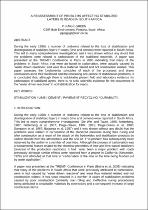JavaScript is disabled for your browser. Some features of this site may not work without it.
- ResearchSpace
- →
- Research Publications/Outputs
- →
- Conference Publications
- →
- View Item
| dc.contributor.author |
Paige-Green, P

|
|
| dc.date.accessioned | 2010-03-12T13:29:03Z | |
| dc.date.available | 2010-03-12T13:29:03Z | |
| dc.date.issued | 2009-11 | |
| dc.identifier.citation | Paige-Green, P. 2009. Reassessment of problems affecting stabilized layers in roads in South Africa. Treatment and Recycling of Materials for Transport Infrastructure (TREMTI 2009). 3rd International Symposium, Antigua, Guatemala, 18-20 November 2009, pp 11 | en |
| dc.identifier.uri | http://hdl.handle.net/10204/3986 | |
| dc.description | TREMTI 2009. 3rd International Symposium, Antigua, Guatemala, 18-20 November 2009 | en |
| dc.description.abstract | During the early 1980s a number of problems related to the loss of stabilization and disintegration of stabilized layers in roads (lime and cement) were reported in South Africa. This led to many comprehensive investigations and it was shown without any doubt that the problems were related to carbonation of the stabilized materials. A paper was presented at the TREMTI Conference in Paris in 2005 indicating that many of the problems in South Africa that were attributed to carbonation, were actually caused by “water driven reactions” and were thus material related and not construction related. This paper assesses the fundamental principles of each of the processes and draws conclusions as to their likelihood and the increasing occurrence of stabilization problems. It is concluded that, although there is indubitable proven field and laboratory evidence for carbonation of stabilized layers, there is no solid scientific evidence for the occurrence of the “water driven reactions” in soil stabilization for roads. | en |
| dc.language.iso | en | en |
| dc.subject | Stabilization | en |
| dc.subject | Lime | en |
| dc.subject | Cement | en |
| dc.subject | Pavement recycling | en |
| dc.subject | Transport infrastructure | en |
| dc.subject | Roads | en |
| dc.title | Reassessment of problems affecting stabilized layers in roads in South Africa | en |
| dc.type | Conference Presentation | en |
| dc.identifier.apacitation | Paige-Green, P. (2009). Reassessment of problems affecting stabilized layers in roads in South Africa. http://hdl.handle.net/10204/3986 | en_ZA |
| dc.identifier.chicagocitation | Paige-Green, P. "Reassessment of problems affecting stabilized layers in roads in South Africa." (2009): http://hdl.handle.net/10204/3986 | en_ZA |
| dc.identifier.vancouvercitation | Paige-Green P, Reassessment of problems affecting stabilized layers in roads in South Africa; 2009. http://hdl.handle.net/10204/3986 . | en_ZA |
| dc.identifier.ris | TY - Conference Presentation AU - Paige-Green, P AB - During the early 1980s a number of problems related to the loss of stabilization and disintegration of stabilized layers in roads (lime and cement) were reported in South Africa. This led to many comprehensive investigations and it was shown without any doubt that the problems were related to carbonation of the stabilized materials. A paper was presented at the TREMTI Conference in Paris in 2005 indicating that many of the problems in South Africa that were attributed to carbonation, were actually caused by “water driven reactions” and were thus material related and not construction related. This paper assesses the fundamental principles of each of the processes and draws conclusions as to their likelihood and the increasing occurrence of stabilization problems. It is concluded that, although there is indubitable proven field and laboratory evidence for carbonation of stabilized layers, there is no solid scientific evidence for the occurrence of the “water driven reactions” in soil stabilization for roads. DA - 2009-11 DB - ResearchSpace DP - CSIR KW - Stabilization KW - Lime KW - Cement KW - Pavement recycling KW - Transport infrastructure KW - Roads LK - https://researchspace.csir.co.za PY - 2009 T1 - Reassessment of problems affecting stabilized layers in roads in South Africa TI - Reassessment of problems affecting stabilized layers in roads in South Africa UR - http://hdl.handle.net/10204/3986 ER - | en_ZA |







